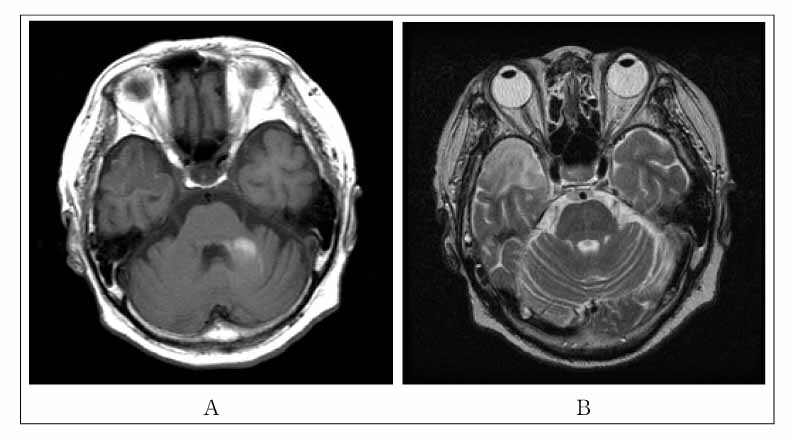Tuberc Respir Dis.
2007 Oct;63(4):382-386.
A Case of Paraneoplastic Limbic Encephalitis Associated with Primary Adenocarcinoma of Lung
- Affiliations
-
- 1Department of Internal Medicine, Hanyang University Guri Hospital, Guri, Korea. jhcmd@hanyang.ac.kr
- 2Department of Radiology, Hanyang University Guri Hospital, Guri, Korea.
Abstract
- Paraneoplastic limbic encephalitis is a rare disorder that is characterized by personality changes, irritability, depression, seizures, memory loss and dementia, and is commonly associated with small cell lung cancer. The cause is unknown but it is believed to be an autoimmune disorder that develops secondary to a carcinomatous process. We report a patient with the clinical feature consistent with limbic encephalitis. A 64-year-old women developed disorientation, memory loss and general weakness. She was diagnosed with NSCLC (adenocarcinoma) with a brain metastasis 1 year earlier and was treated with radiation and chemotherapy. Although the lung mass and brain metastatic lesions had improved, the brain T2-weighted MRI showed high signal intensity in the right temporal region. This lesion consisted of with limbic encephalitis and was negative to the other viral and immune markers. The patient's symptoms did not improve after steroid treatment. Our case demonstrated that a NSCLC (adenocarcinoma) also can be associated with paraneoplastic limbic encephalitis.
MeSH Terms
Figure
Reference
-
1. Corsellis JA, Goldberg GJ, Norton AR. "Limbic encephalitis" and its association with carcinoma. Brain. 1968. 91:481–496.2. Cakirer S. Paraneoplastic limbic encephalitis: case report. Comput Med Imaging Graph. 2002. 26:55–58.3. Gultekin SH, Rosenfeld MR, Voltz R, Eichen J, Posner JB, Dalmau J. Paraneoplastic limbic encephalitis: neurological symptoms, immunologic findings and tumor association in 50 patients. Brain. 2000. 123:1481–1494.4. Dalmau J, Bataller L. Clinical and immunological diversity of limbic encephalitis: a model for paraneoplastic neurologic disorders. Hematol Oncol Clin North Am. 2006. 20:1319–1335.5. Vedeler CA, Antoine JC, Giometto B, Graus F, Grisold W, Hart IK, et al. Management of paraneoplastic neurological syndromes. Eur J Neurol. 2006. 13:682–690.6. Cho TY, Kim YJ, Lee BI, Huh K. A case of limbic encephalitis associated with small cell lung cancer about diagnostic MRI findings. J Korean Neurol Assoc. 1994. 12:338–342.7. Cho HJ, Jo JW. A case of paraneoplastic limbic encephalitis associated with immature teratoma. J Korean Neurol Assoc. 2003. 21:647–650.8. Seo KY, Hur SY, Kim SJ, Park TC, Bae SN, Han GT, et al. A Clinicopathologic study of immature teratoma of the ovary. Korean J Obstet Gynecol. 2004. 47:2389–2396.9. Hiasa Y, Kunishige M, Mitsui T, Kondo S, Kuriwaka R, Shigekiyo S, et al. Complicated paraneoplastic neurological syndromes: a report of two patients with small cell or non-small cell lung cancer. Clin Neurol Neurosurg. 2003. 106:47–49.10. Darnell RB, Posner JB. Paraneoplastic syndromes involving the Nervous system. N Engl J Med. 2003. 349:1543–1554.11. Kim KK. Paraneoplastic syndrome. J Korean Neurol Assoc. 2002. 20:215–222.12. Aydiner A, Gurvit H, Baral I. Paraneoplastic limbic encephalitis with immature ovarian teratoma. J Neurooncol. 1998. 37:63–66.13. Messori A, Lanza C, Serio A, Salvolini U. Resolution of limbic encephalitis with detection and treatment of lung cancer: clinicalradiological correlation. Eur J Radiol. 2003. 45:78–80.14. Voltz R. Paraneoplastic neurological syndromes: an update on diagnosis, pathogenesis, and therapy. Lancet Neurol. 2002. 1:294–305.15. Pittock S, Kryzer TJ, Lennon VA. Paraneoplastic antibodies coexist and predict cancer, not neurological syndrome. Ann Neurol. 2004. 56:715–719.16. Vernino S, Lennon VA. New Putkinje cell antibody(PCA-2): marker of lung cancer-related neurological autoimmunity. Ann Neurol. 2000. 47:297–305.
- Full Text Links
- Actions
-
Cited
- CITED
-
- Close
- Share
- Similar articles
-
- Non-paraneoplastic Autoantibody-negative Limbic Encephalitis Characterized by Mild Memory Impairment: A Case Report
- A Case of Paraneoplastic Limbic Encephalitis Associated with Immature Ovarian Teratoma
- A Case of Limbic Encephalitis Associated with Small Cell Lung Cancer: About Diagnostic MRI Findings
- Anti-Ma2-Associated Encephalitis with Axonal Sensorimotor Polyneuropathy
- Anti-Ma2-Associated Encephalitis Presenting as Hypersomnia




